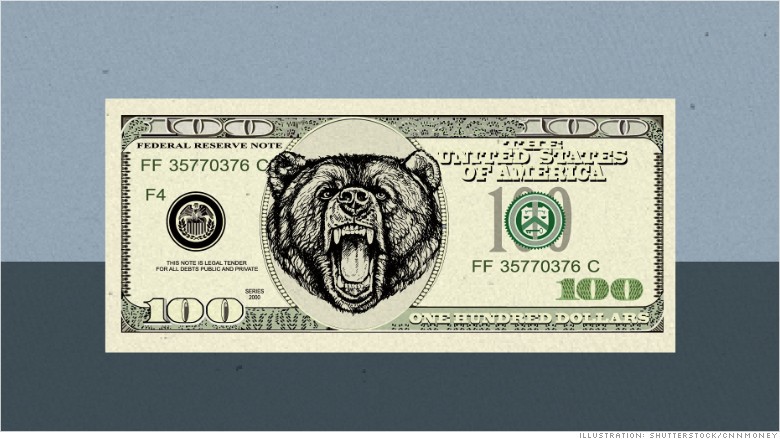
Wall Street's bears are back in vogue.
After nearly six years of a surging U.S. stock market, investors are worried about how much longer it will last. Suddenly, the views of the negative Nancys are getting a lot of attention.
The bears build their case that a crisis is near on four factors: falling oil prices, stagnant wages, the "two-edged sword" of a strong US dollar and big trouble abroad.
"Earnings and economic activity are actually weakening, not strengthening," says James Abate, chief investment officer at Centre Asset Management, which manages over $8 billion. "The growth outlook, to us, is deteriorating."
Related: Don't expect a big raise in 2015
The dollar dilemma: One of the biggest problems companies face right now is the strong U.S. dollar. The euro recently hit an 11-year low of about $1.10 to the euro. It may sound good -- it's more affordable travel to Europe -- but it hurts U.S. companies selling their products abroad.
U.S. exported goods are quickly becoming more expensive -- and less attractive -- to foreign buyers.
Related: One dollar could soon equal one euro
Consider that Microsoft (MSFT) reported solid earnings Tuesday, but its shares dropped as much as 10% because it's forecasting weaker sales abroad due to the strong U.S. dollar. The same is true for Procter & Gamble (PG) and United Technologies (UTX), some of America's biggest companies, which employ thousands.
"There are limits to how much further the U.S. dollar can appreciate before it starts to bite more seriously into economic activity," says Sheryl King, senior director of research at Roubini Global Economics and a former Bank of America economist.
Oil's onerous cost: Similar to the dollar, there are two sides to the dramatic drop in oil prices from over $100 a barrel last summer to $45 now. Americans love cheap gas at the pump, but low oil prices are forcing corporations to scale back on jobs and spending.
The oil sector has added over a half million jobs -- many of them high paying -- since the recession ended in June 2009. That's 13% of all US job growth over that period.
Now energy companies and related sectors are laying off thousands. Expect that trend to continue, bears say.
Related: oil boomtown on the brink of bust?
"The plunge in oil prices will continue and lead to more, I think, worry comments as these companies start to report each quarter," says Brian Sozzi, chief equity strategist at Belus Capital Advisors.
It's already hurting corporate earnings. Take Tuesday, for example: the Dow fell 291 points after Caterpillar (CAT), the nation's largest building equipment company, reported a 25% decline in profits due to business slowdown in oil-producing regions.
Concerns abroad: Beyond oil, the global economic picture makes bears believe that the U.S. cannot be the tug boat pulling everyone ahead.
Related: New year, same old problems for Europe
Growth in China is slowing. The Swiss National Bank ignited a "currency war" this month after a surprise move. The European Central Bank is throwing a life raft to its nations drowning in deflation, and Japan is already deflating.
On top of that, Greece just elected a leader almost certain to cause tension with other European leaders and tensions are flaring up again between Russia and the Ukraine.
"Everyone seems to be falling or faltering in some way," abroad, says Matt Kerkhoff, research director at Dow Theory Letters, an online newsletter. The American economy, "cannot really outperform while all the rest are in shambles."
A shift at the Fed: The question is whether American consumers and businesses will spend enough to offset the global slowdown. But so far, wages have been flat for many Americans during the recovery.
Adjusting for inflation, median weekly wages were $790 in the fourth quarter of 2007; they barely budged up 1% to $796 the last quarter of 2014.
While jobs and economic activity gained momentum last year, wages still lag behind. Some bears see wages, not job growth, becoming the key deciding factor for the Federal Reserve to raise interest rates. The central bank will make its first policy announcement of 2015 on Wednesday.
Related: Warning sign: Stocks take nosedive
Experts across the spectrum see 3.5% wage growth as the key number the Fed wants to see before it raises rates. At the moment, wage growth is only 1.7% annually.
"The reality is, until wage inflation goes up, I think the Fed is going to stay on hold for as long as it takes, if ever basically," says Abate of Centre Asset Management. "Productivity is going down, not up. And that's a big problem to real wage gains."
Weaving their four factors together, the bears' quilt for 2015 is quickly looking gloomy and gray. The U.S. markets are already overdue for a correction -- a drop of 10% or more -- and this global backdrop could exacerbate the fall when it comes.


